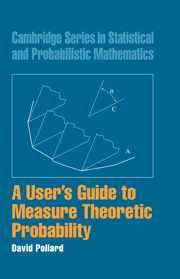Book contents
- Frontmatter
- Contents
- PREFACE
- CHAPTER 1 MOTIVATION
- CHAPTER 2 A MODICUM OF MEASURE THEORY
- CHAPTER 3 DENSITIES AND DERIVATIVES
- CHAPTER 4 PRODUCT SPACES AND INDEPENDENCE
- CHAPTER 5 CONDITIONING
- CHAPTER 6 MARTINGALE ET AL.
- CHAPTER 7 CONVERGENCE IN DISTRIBUTION
- CHAPTER 8 FOURIER TRANSFORMS
- CHAPTER 9 BROWNIAN MOTION
- CHAPTER 10 REPRESENTATIONS AND COUPLINGS
- CHAPTER 11 EXPONENTIAL TAILS AND THE LAW OF THE ITERATED LOGARITHM
- CHAPTER 12 MULTIVARIATE NORMAL DISTRIBUTIONS
- APPENDIX A MEASURES AND INTEGRALS
- APPENDIX B HILBERT SPACES
- APPENDIX C CONVEXITY
- APPENDIX D BINOMIAL AND NORMAL DISTRIBUTIONS
- APPENDIX E MARTINGALES IN CONTINUOUS TIME
- APPENDIX F DISINTEGRATION OF MEASURES
- INDEX
CHAPTER 8 - FOURIER TRANSFORMS
Published online by Cambridge University Press: 29 March 2011
- Frontmatter
- Contents
- PREFACE
- CHAPTER 1 MOTIVATION
- CHAPTER 2 A MODICUM OF MEASURE THEORY
- CHAPTER 3 DENSITIES AND DERIVATIVES
- CHAPTER 4 PRODUCT SPACES AND INDEPENDENCE
- CHAPTER 5 CONDITIONING
- CHAPTER 6 MARTINGALE ET AL.
- CHAPTER 7 CONVERGENCE IN DISTRIBUTION
- CHAPTER 8 FOURIER TRANSFORMS
- CHAPTER 9 BROWNIAN MOTION
- CHAPTER 10 REPRESENTATIONS AND COUPLINGS
- CHAPTER 11 EXPONENTIAL TAILS AND THE LAW OF THE ITERATED LOGARITHM
- CHAPTER 12 MULTIVARIATE NORMAL DISTRIBUTIONS
- APPENDIX A MEASURES AND INTEGRALS
- APPENDIX B HILBERT SPACES
- APPENDIX C CONVEXITY
- APPENDIX D BINOMIAL AND NORMAL DISTRIBUTIONS
- APPENDIX E MARTINGALES IN CONTINUOUS TIME
- APPENDIX F DISINTEGRATION OF MEASURES
- INDEX
Summary
SECTION 1 presents a few of the basic properties of Fourier transforms that make them such a valuable tool of probability theory.
SECTION 2 exploits a mysterious coincidence, involving the Fourier transform and the density function of the normal distribution, to establish inversion formulas for recovering distributions from Fourier transforms.
SECTION *3 explains why the coincidence from Section 2 is not really so mysterious.
SECTION 4 shows that the inversion formula from Section 2 has a continuity property, which explains why pointwise convergence of Fourier transforms implies convergence in distribution.
SECTION *5 establishes a central limit theorem for triangular arrays of martingale differences.
SECTION 6 extends the theory to multivariate distributions, pointing out how the calculations reduce to one-dimensional analogs for linear combinations of coordinate variables—the Cramér and Wold device.
SECTION *7 provides a direct proof (no Fourier theory) of the fact that the family of (one-dimensional) distributions for all linear combinations of a random vector uniquely determines its multivariate distribution.
SECTION *8 illustrates the use of complex-variable methods to prove a remarkable property of the normal distribution—the Lévy-Cramér theorem.
Definitions and basic properties
Some probabilistic calculations simplify when reexpressed in terms of suitable transformations, such as the probability generating function (especially for random variables taking only positive integer values), the Laplace transform (especially for random variables taking only nonnegative values), or the moment generating function (for random variables with rapidly decreasing tail probabilities).
Information
- Type
- Chapter
- Information
- A User's Guide to Measure Theoretic Probability , pp. 193 - 210Publisher: Cambridge University PressPrint publication year: 2001
